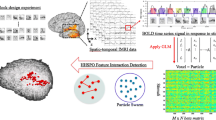Abstract
Functional magnetic resonance imaging (FMRI) is an imaging technique for determining which regions of the brain are activated in response to a stimulus or event. Early FMRI experiment paradigms were based upon those used in positron emission tomography (PET), i.e. employing a block design consisting of extended periods of ‘on’ against ‘off’ activations. More recent experiments were based on event-related FMRI, harnessing the fact that very short stimuli trains or single events can generate robust responses. FMRI data suffer from low signal-to-noise ratios, and typical event-related experiment paradigms employ selective averaging over many trials before using statistical methods for determining active brain regions. The paper reports a pattern recognition approach to the detection of single-trial FMRI responses without recourse to averaging and at modest field strengths (1.5T). Linear discriminant analysis (LDA) was applied in conjunction with different feature extraction techniques. Use of the unprocessed data samples as features resulted in singletrial events being classified with an accuracy of 61.0±9.5% over five subjects. To improve classification accuracy, knowledge of the ideal template haemodynamic response was used in the feature extraction stage. A novel application of parametric modelling yielded an accuracy of 69.8±6.3%, and a matched filtering approach yielded an accuracy of 71.9±5.4%. Single-trial detection of event-related FMRI may yield new ways of examining the brain by facilitating new adaptive experiment designs and enabling tight integration with other single-trial electrophysiological methods.
Similar content being viewed by others
References
Baher, H. (2001): ‘Analog and digital signal processing’, 2nd edn (John Wiley and Sons, 2001)
Bishop, C. M. (1995): ‘Neural networks for pattern recognition’ (Clarendon Press, Oxford, 1995)
Boynton, G. M., Engel, S. A., Glover, G. H., andHeeger, D. J. (1996): ‘Linear systems analysis of functional magnetic resonance imaging in human VI’,J. Neurosci.,16, pp. 4207–4221
Cerutti, S., Chiarenza, G., Liberati, D., Mascellani, P., andPavesi, G. (1988): ‘A parametric method of identification of singletrial event-related potentials in the brain’,IEEE Trans. Biomed. Eng.,35, pp. 701–711
Cohen, M. S. (1997): ‘Parametric analysis of fMRI data using linear systems methods’,NeuroImage,6, pp. 93–103
Cohen, M. S., andBookheimer, S. Y. (1994): Localization of brain function using magnetic resonance imaging’,Trends Neurosci.,17, pp. 268–277
Dale, A. M. andSereno, M. I. (1993): ‘Improved localization of cortical activity by combining EEG and MEG with MRI cortical surface reconstruction: a linear approach’,J. Cognit. Neurosci.,5, pp. 162–176
Deller, J. R., Hansen, J. H. L., andProakis, J. G. (2000): ‘Discrete-time processing of speech signals’, (IEEE Press, 2000)
Garavan, H., Ross, T. J., andStein, E. A. (1999): ‘Right hemispheric dominance of inhibitory control: An event-related functional MRI study’,Proc. Natl. Acad. Sci.,86, pp. 8301–8306
Huang-Hellinger, F. R., Breiter, H. C., McCormack, G., Cohen, M. S., Kwong, K. K., Sutton, J. P., Savoy, R. L., Weisskoff, R. M., Davis, T. L., Baker, J. R., Belliveau, J. W., andRosen, B. R. (1995): ‘Simultaneous functional magnetic resonance imaging and electrophysiological recording’,Human Brain Mapping,3, pp. 13–25
Josephs, O., Turner, R., andFriston, K. (1997): ‘Event-related fMRI’,Human Brain Mapping,5, pp. 243–248
Kwong, K. K., Belliveau, J. W., Chesler, D. A., Goldberg, I. E., Weisskoff, R. M., Poncelet, B. P., Kennedy, D. N., Hoppel, B. E., Cohen, M. S., Turner, R., et al. (1992): ‘Dynamic magnetic resonance imaging of human brain activity during primary sensory stimulation’,Proc. Natl. Acad. Sci.,89, pp. 5675–5679
Ljung, L. (1987): ‘System identification: theory for the user’ (Prentice Hall, 1987)
McCarthy, G., Luby, M., Gore, J., andGoldman-Rakic, P. (1997): ‘Infrequent events transiently activate human prefrontal and parietal cortex as measured by functional MRI’,J. Neurophysiol.,77, pp. 1630–1634
Rosen, B. R., Buckner, R. L., andDale, A. M. (1998): ‘Eventrelated functional MRI: past, present, and future’,Proc. Natl. Acad. Sci.,95, pp. 773–780
Tegeler, C., Strother, S. C., Anderson, J. R., andKim, S.-G. (1999): ‘Reproducibility of BOLD-based functional MRI obtained at 4 T’,Human Brain Mapping,7, pp. 267–283
Weisskoff, R. M., Baker, J. R., Belliveau, J. W., Davis, T. K., Kwong, K. K., Cohen, M. S., andRosen, B. R. (1993): ‘Power spectrum analysis of functionally-weighted MR data: What's in the noise?’,Soc. Magnet. Resonance Med., p. 7
Author information
Authors and Affiliations
Corresponding author
Rights and permissions
About this article
Cite this article
Burke, D., Murphy, K., Garavan, H. et al. Pattern recognition approach to the detection of single-trial event-related functional magnetic resonance images. Med. Biol. Eng. Comput. 42, 604–609 (2004). https://doi.org/10.1007/BF02347541
Received:
Accepted:
Issue Date:
DOI: https://doi.org/10.1007/BF02347541




